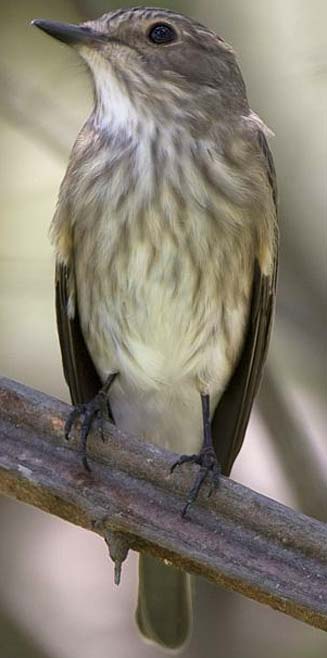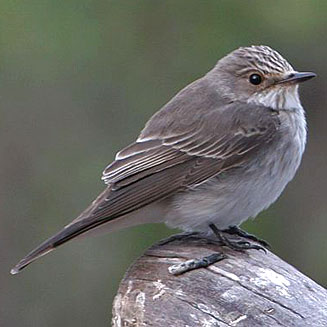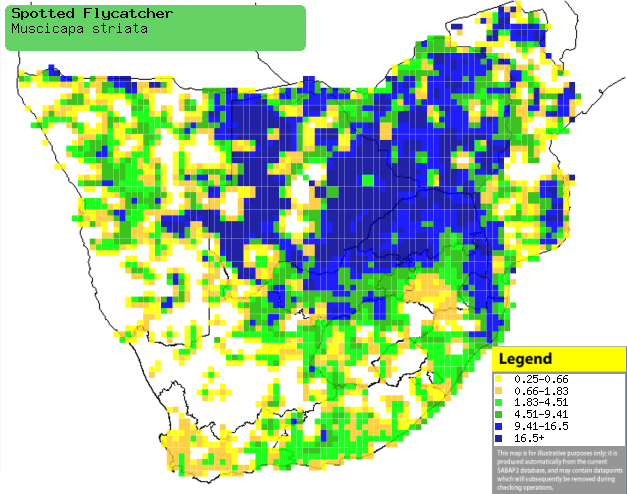|
Muscicapa striata (Spotted flycatcher)
Europese vlieŽvanger [Afrikaans]; Kapantsi-tubatubi [South Sotho]; Grauwe
vliegenvanger [Dutch]; Gobemouche gris [French]; Grauschnšpper [German];
Papa-moscas-cinzento [Portuguese]
Life
> Eukaryotes >
Opisthokonta
> Metazoa (animals) >
Bilateria >
Deuterostomia > Chordata >
Craniata > Vertebrata (vertebrates) > Gnathostomata (jawed
vertebrates) > Teleostomi (teleost fish) > Osteichthyes (bony fish) > Class:
Sarcopterygii (lobe-finned
fish) > Stegocephalia (terrestrial
vertebrates) > Tetrapoda
(four-legged vertebrates) > Reptiliomorpha > Amniota >
Reptilia (reptiles) >
Romeriida > Diapsida > Archosauromorpha > Archosauria >
Dinosauria
(dinosaurs) > Saurischia > Theropoda (bipedal predatory dinosaurs) >
Coelurosauria > Maniraptora > Aves
(birds) >
Order: Passeriformes > Family: Muscicapidae
> Genus: Muscicapa
 |
 |
 |
|
Spotted flycatcher, Thornybush Game Reserve, South
Africa. [photo Trevor Hardaker ©] |
Top right: Spotted flycatcher, West Coast National Park,
South Africa. [photo Trevor Hardaker ©]
Bottom right: Spotted flycatcher. [photo
Neil Gray
©] |
Distribution and habitat
Occurs across Africa south of the Sahel, extending further
north through Sudan and Egypt to most of Europe and central Asia. In southern
Africa it is common and widespread, as it can occupy almost any open habitat
with low perches, even moving into the Namib Desert of Namibia if there are
adequate perches available. It is regularly visits gardens with trees, and may
also move into previously barren areas if they have stands of alien trees, such
as pine (Pinus) plantations in the Free State Province.
|
 |
|
Distribution of Spotted flycatcher in southern Africa,
based on statistical smoothing of the records from first SA Bird Atlas
Project (©
Animal Demography unit, University of
Cape Town; smoothing by Birgit Erni and Francesca Little). Colours range
from dark blue (most common) through to yellow (least common).
See here for the latest distribution
from the SABAP2. |
Movements and migrations
Palearctic summer migrant, breeding in
north-western Africa and Eurasia and flying south to sub-Saharan
africa in the non-breeding season. It typically arrives in southern
Africa during the period from mid October to late November, leaving
around mid March to early April.
Food
It mainly eats insects, doing most of its foraging from a
low perch from which it hawks insects from the air, often moving from perch to
perch in search of more food. The following food items have been recorded
in its diet:
- Animals
- Plants
- fruit
- Trema orientalis (Pigeonwood)
- Ochna pretoriensis (Magalies ochna)
- seeds of Helianthus (sunflower)
Threats
Not threatened, in fact widespread and common.
References
-
Hockey PAR, Dean WRJ and Ryan PG 2005. Roberts
- Birds of southern Africa, VIIth ed. The Trustees of the John Voelcker
Bird Book Fund, Cape Town.
|
